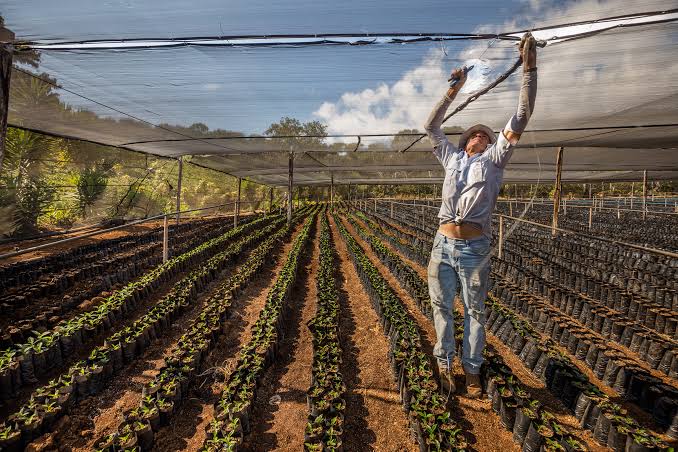Another paper, in the journal Proceedings of the National Academy of Sciences, suggests that that number could be as high as 88% in Latin America.
另一篇發表在《美國國家科學院院刊》上的論文表明,在拉丁美洲,這一比例可能高達88%。
While rising temperatures have caught many industries flat-footed, coffee companies have responded in force,
盡管氣溫上升打了許多行業一個措手不及,咖啡企業們卻做出了有力的回應,
bolstering their presence on the ground in coffee-growing countries like Costa Rica, Ethiopia and Indonesia.
鞏固了他們在哥斯達黎加、埃塞俄比亞和印度尼西亞等咖啡種植國的存在。
Instead of just purchasing coffee, they work with small farms to help them adapt to changing conditions,
除了購買咖啡,他們還與小農場展開合作,幫助他們適應不斷變化的條件,
providing seeds, monitoring production and suggesting new agricultural practices.
為他們提供種子,幫助他們監控生產環節,還提出了諸多農業種植新舉措。
“Everybody talks about climate, but the only sector that’s actually doing something at scale is the coffee industry,”
國際保護組織CEO桑賈揚在我們參觀阿拉胡埃拉省的星巴克農場的途中告訴我:
Mr. Sanjayan, the CEO of Conservation International, tells me as we tour the Starbucks farm in Alajuela.
“人人都在談氣候變化,但真正采取大規模行動的只有咖啡業”。
Not that the industry sees a choice.
并非這個行業有選擇的余地。
Declining supplies and a growing coffee-drinking population mean climate change could turn a daily pick-me-up into a high-priced luxury,
而是因為供應下降和喝咖啡的人口增長意味著氣候變化可能會把每天的提神飲料變成高價的奢侈品,
threatening the continued growth of the industry’s customer base.
威脅到該行業客戶群的持續增長。
Addressing that challenge was an important facet of Schultz’s job in his final years at Starbucks.
由此,應對這一挑戰便成了舒爾茨在星巴克最后幾年的一大工作重點。

“It’s not only about the environment,” he says of his work on climate change.
“不僅是因為環境,”他談到自己在氣候變化方面的工作時說道。
“It’s also to procure high-quality coffee, to get the best possible yield, at the best possible price.”
“也是為了獲得高品質的咖啡,以盡可能理想的價格獲得盡可能理想的產量。”
DURING OUR VISIT to the Starbucks farm, Schultz stops at the company’s Costa Rican farmer support center.
在我們參觀星巴克農場途中,舒爾茨在公司的哥斯達黎加農民支持中心停了下來。
The structure is designed to accommodate crops brought in fresh from the field,
該中心設計的初衷是為存貯剛從地里收獲的新鮮咖啡,
but still maintains the gloss of a corporate office for the high-level executives who cycle through on occasion.
同時還保有公司辦公室的光鮮之感,供偶爾到訪的高層管理人員使用。
Schultz greets Carlos Mario Rodriguez, director of global agronomy at Starbucks, with a big smile and a familiar handshake.
舒爾茨面帶微笑,親切地與星巴克全球農藝總監卡洛斯·馬里奧·羅德里格斯握手致意。
In this building, Rodriguez meets with local farmers,
羅德里格斯就在這棟樓里與當地農民見面,
offering them different seed varieties developed on-site and advising them on how to protect their yield in the face of a changing climate.
為他們提供就地培育的其他品種以及指導他們如何在氣候變化條件下穩固產量的建議。
When he’s not teaching planters, Rodriguez, the former head of Costa Rica’s national coffee institute,
在教授農民的間隙,羅德里格斯——他也是哥斯達黎加國家咖啡研究所的前負責人——
spends his days among the coffee trees on the property,
的每一天都是在農場的咖啡樹下度過的,
surveying experiments designed to develop the perfect coffee bean—one that can survive drought and heat while also meeting the company’s quality standards.
日復一日地審視培育完美咖啡豆,即既能經受干旱和高溫,又能達到公司的品質標準的咖啡豆的實驗。
On the farm, he stops to show me one 4,300-sq.-ft. field
在農場上,他停下來給我介紹了一片4300平方英尺的地,
where he says 50 new coffee varietals are being tested for their climate resilience as well as taste.
他說,有50種新的咖啡品種正在那片種植地接受氣候適應性和口味的測試。
譯文由可可原創,僅供學習交流使用,未經許可請勿轉載。













